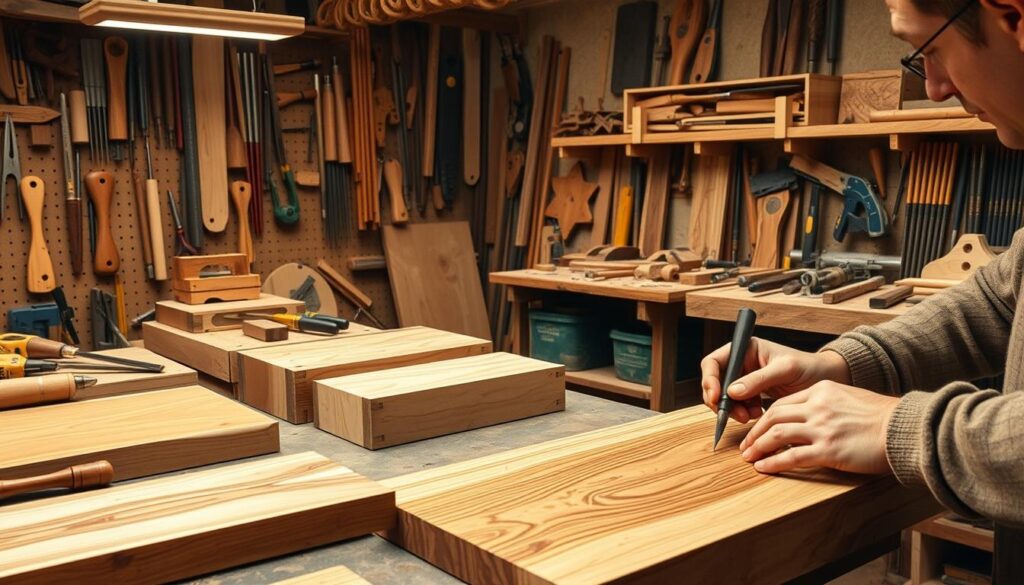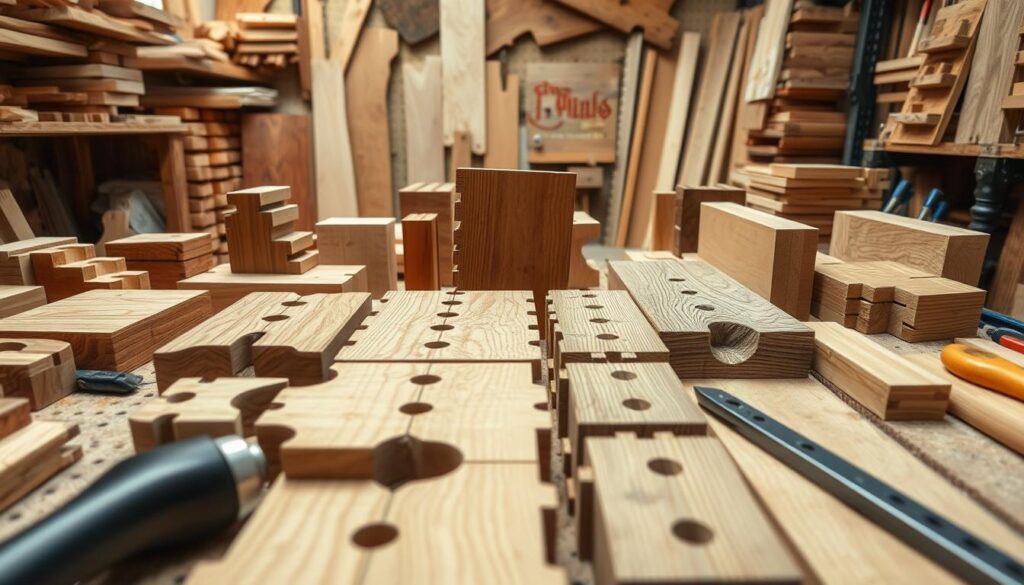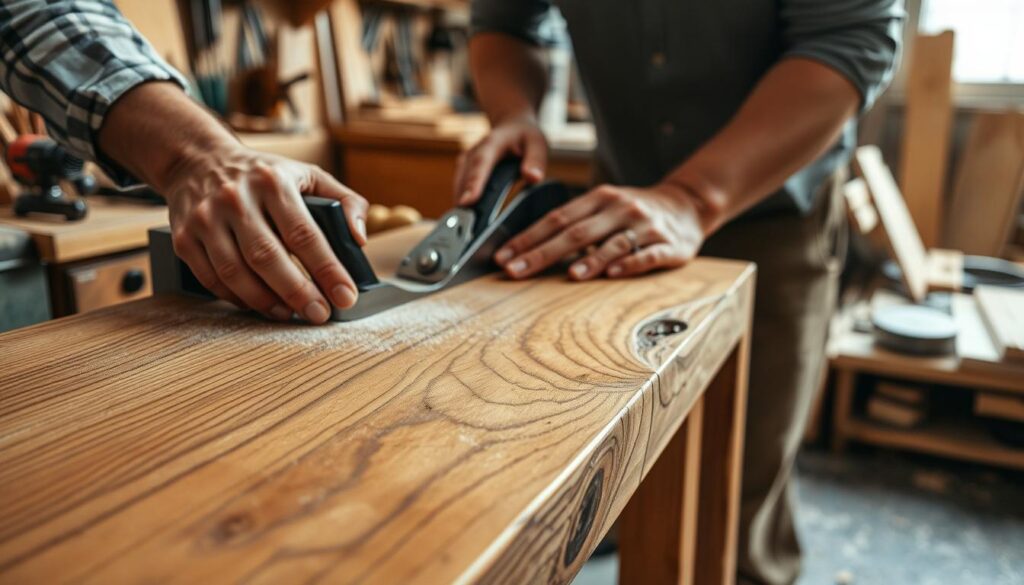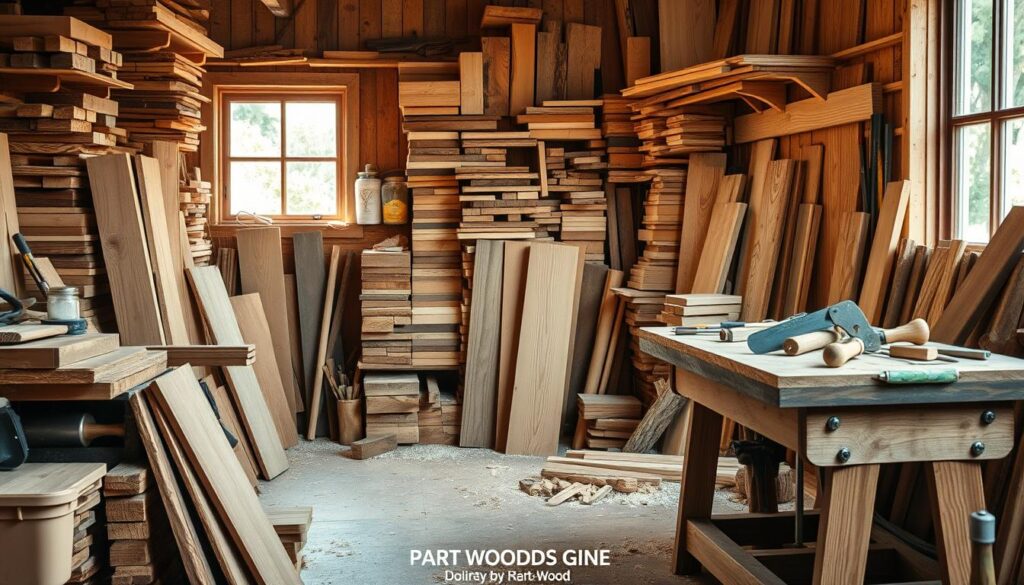Every time I hold a piece of raw lumber, I feel a deep connection to the trees and the earth. This bond links me to all the woodworkers who came before. Advanced woodworking is a blend of precision and creativity, turning the ordinary into something truly special.
I invite you to join me on a journey to improve your woodworking skills. Here, success is all about the small details. Your creations will become more than just furniture; they will be lasting legacies of your craftsmanship.
Whether you’re making spindles on the lathe or shaping armrests, precision and creativity are key1. Choosing the best materials and keeping your tools in top shape is essential. Every detail in your workspace matters.
The woodworking industry values safety and quality in every piece you make1. It’s not just a hobby; it’s a quest for excellence in woodworking.
Table of Contents
ToggleKey Takeaways
- Embrace creativity to transform simple wood into masterpieces.
- Advanced techniques ensure your work’s durability and aesthetic appeal.
- Tool maintenance, materials selection, and workspace optimization are crucial.
- Access a wealth of tips to cater to woodworkers of all skill levels.
- Learn the importance of community in the continuous growth of craftsmanship.
- Advanced woodworking isn’t just a craft; it’s a call to action for all who aspire to create with excellence.
>>Get 16,000 Woodworking Plans
Understanding Advanced Woodworking Techniques
Exploring Advanced Crafting Techniques is a mix of old traditions and new tech. It takes woodworking to new levels. It combines the wisdom of the past with today’s precision.
Definition and Importance
The beauty of Woodworking Artistry lies in combining strength and beauty in each piece.
Historical Context
Woodworking has evolved from basic to art over time. It started in ancient times as a necessity and art form. Today, I mix old knowledge with Advanced Crafting Techniques like dovetail fits2.
Every piece I make honors the legacy of woodworking. It shows how Woodworking Evolution has grown over centuries.
Current Trends in Woodworking
Today, woodworking focuses on precision and efficiency thanks to new tech. I use digital tools for planning, improving my work’s accuracy2. Modern woodworking blends hands-on creativity with digital precision, showing Woodworking Evolution.
Stay updated with tools like those from VirutexTools to keep your techniques fresh2.
Combine old woodworking methods with new tools. This mix keeps craftsmanship alive while exploring new ideas.

Advanced woodworking is more than just using complex tools. It’s about always learning and applying new ideas. Keeping your workshop safe, learning new methods, and joining woodworking communities are key2.
Essential Tools for Advanced Woodworking
Advanced woodworking needs a strong set of tools. These tools make crafting easier, improve precision, and keep you safe. You’ll need both power and hand tools, and know how to stay safe while working with wood.
Must-Have Power Tools
A good workshop has many power tools. Pocket hole jigs to 3-phase converters are key for many projects3. Different nail guns3 are needed for various tasks. A laser level, costing about $1503, helps ensure parts fit together right.
Hand Tools for Precision
- Chisels
- Measuring Tapes
- Levels
- Screwdrivers
- Fine Grit Sandpaper
Hand tools are great for detailed work. They give you control and let you connect with the wood. Starting with basic tools like chisels and a sharpening stone4 can save money.
Safety Gear and Equipment
Keeping your workspace safe is key in advanced woodworking. Wear safety glasses, gloves, and dust masks to protect yourself. Following safety rules helps avoid injuries and keeps your work area productive. A dust collection system also helps keep your space clean and safe.

As you move to more complex projects, the right tools become more important. Each tool plays a role in making your work better and safer. Buying tools as you need them can save money and fit your project’s needs4.
Advanced Joinery Techniques
Exploring Fine Woodworking has made me love Intricate Joinery even more. It’s especially true when I’m working on top-notch Furniture Making. These advanced techniques make each piece stronger and more beautiful.
Mortise and Tenon
The mortise and tenon joint is both old and powerful. It’s great for making cabinets and frames strong. By fitting the tenon into the mortise, it creates a joint that’s hard to break. This skill is key for making furniture that lasts5.
Dovetail Joints
Dovetail joints are known for being hard to pull apart. They’re also beautiful, making them perfect for drawers. The way they fit together shows off the woodworker’s skill. These joints make the furniture look and feel better5.
Biscuit Joints
Biscuit joints are great for pieces that need to look good and work well. They use oval-shaped pieces to join wood, making it look seamless. I use them for things like tabletops where looks matter but strength is still important.
Pocket Hole Joinery
Pocket hole joinery is perfect for quick, strong joints. It uses a screw in a pre-drilled hole to join wood at an angle. It’s great for starting cabinets or making changes without messing up the look.

Learning these advanced joinery techniques has really grown my love for Fine Woodworking. Every project is a chance to get better and try new things. Whether it’s the classic mortise and tenon, the strong dovetail joints, or the simple biscuit and pocket hole joints, each has its own special benefits. They all help me make furniture that’s both beautiful and durable.
Fine Finishing Techniques
The art of wood finishing combines skill, advanced techniques, and attention to detail. It creates lasting beauty and durability in wood projects. We see a mix of old methods and new ideas that make wood look great and work well.
Sanding and Surface Preparation
Sanding is key to perfect wood finishing. You start with 80-grit sandpaper, then move to 120-grit, and end with 180-grit. This makes the surface ready for more treatments6.
Using a random orbital sander at 1 inch per second is best. It makes the surface even and scratch-free6. This careful step is crucial for top-notch craftsmanship.
Staining and Coloring
When staining, some woods like birch and maple can take stains unevenly. This can cause blotches6. Knowing this helps choose the right stain and techniques to enhance the wood’s beauty.
Stains and dyes can change the look of wood. They can make less expensive woods look more expensive7.
Sealing and Topcoats
Sealing and topcoats protect the wood and make it look better. Varnish is a classic choice for its durability. It’s made by dissolving natural resins in heated oils7.
For a glossy finish, apply a gloss coat and then lightly sand with 320-grit sandpaper. Finish with a sprayed coat for a professional look6. Oil-based polyurethane is good for hard-to-reach areas, giving a clean finish6.
>>Get 16,000 Woodworking Plans

Using these detailed techniques in your projects makes them stand out. They look great and last long, showing true craftsmanship in wood finishing.
Wood Selection and Preparation
Choosing the right wood is key for great woodworking projects. It affects how the project looks and works. Knowing about wood types is essential, whether you’re carving, veneering, or building.
Types of Wood for Advanced Projects
Exotic woods have unique patterns that add visual appeal. But, they might need to be ordered from timber merchants8.
Preparing Wood for Use

Understanding Wood Grain and Characteristics
Knowing these wood properties helps you get better results and avoid problems during making.
In short, picking and preparing wood right is crucial for woodworking success. It requires understanding wood types and using the right tools. With this knowledge, woodworkers can improve their skills in carving, veneering, and more.
Incorporating Technology in Woodworking
I’ve seen a big change in woodworking, thanks to new technology. This change brings precision, efficiency, and new ideas to the craft. It’s really changed how we make things out of wood.
CAD Software for Design
Woodworking CAD design has changed how we design and make things. AI in CAD tools helps plan and visualize projects better. With tools like SketchUp, I can analyze projects in real-time and add green practices easily11.
AI also lets us try new and creative designs. This makes our work more exciting and meets our clients’ needs better11.
CNC Machines and Their Benefits
Also, CNC machines are safer now, thanks to new safety features like automatic guards and stops13.
Utilizing Digital Tools for Precision
Virtual reality (VR) for design adds a new level of interaction. It lets clients see what the final product will look like before we start making it11.
>>Get 16,000 Woodworking Plans

| Technology | Benefits |
|---|---|
| CNC Woodworking | Precision in cuts and designs, Time efficiency |
| CAD Software | Enhanced design accuracy, Real-time project analysis |
| VR Design Tools | Realistic project previews, Improved client interaction |
| AI Integration | Innovative design generation, Resource optimization |
| Laser Cutting | Clean cuts and engravings, Minimal finishing required |
Creating Custom Furniture
Custom furniture making is a mix of careful craftsmanship and new design ideas. It lets me make pieces that are both useful and show off a personal style. These pieces meet the special needs of my clients and have a unique touch that mass-made items don’t.
Designing Unique Pieces
Every project begins with a deep talk to get the client’s vision and needs. I draw from many sources, like current design trends, to come up with ideas. The goal is to turn these ideas into designs that reflect the client’s personality and style.
Building Techniques for Customization
The building part of making custom furniture is all about being precise yet flexible. I use advanced woodworking methods, like dovetail joints14 and mortise-and-tenon14, to make sure the furniture is strong and meets the client’s design wishes. These techniques are key for making wood creations that look good and work well.
Finishing Techniques for One-of-a-Kind Creations
Getting the finish just right takes a lot of steps, including sanding. Choosing the right sandpaper and using both hand and power sanders are important for a top-notch finish15. Then, I carefully apply stains and seals to highlight the wood’s beauty and protect it. This care ensures the furniture looks great and lasts a long time.

There’s joy in making custom furniture because it turns an idea into something loved for years. It’s more than just woodworking; it’s about leaving a mark of skilled craftsmanship and lasting design. Through custom furniture, I give clients a piece of art that’s both beautiful and uniquely theirs.
Sustainability in Woodworking
As someone who loves eco-friendly woodworking, I’ve learned how important sustainability is. Using green woodcraft helps save our planet and makes our work better and more real.
Sourcing Sustainable Materials
Looking for sustainable wood is a big deal. We choose materials like responsibly sourced lumber or reclaimed wood. This helps reduce the need to cut down trees, which is good for forests16. Tools like Life Cycle Assessment (LCA) help us see how wood production and transport affect the environment. This way, we can make our impact smaller17.
Eco-friendly Finishing Techniques
In green woodcraft, using eco-friendly finishes is key. Low-VOC paints and plant-based oils are better for the air and make our work last longer. New materials like nanocellulose make wood surfaces better and more water-resistant17.
Upcycling and Repurposing Wood
Upcycling and repurposing wood are big in eco-friendly woodworking. We turn small pieces into something new, like decorations or parts of other projects16. This way, we save resources and create something special that people love.
Let’s look at some data on sustainable materials:
| Material | Sustainability Benefit | Usage |
|---|---|---|
| Laminated Veneer Lumber (LVL) | High strength, minimal environmental impact | Structural applications |
| Cross-Laminated Timber (CLT) | Reduces CO2 emissions, durable | Building construction |
| Recycled Wood Plastic Composites | Low maintenance, utilizes recycled materials | Flooring, outdoor applications |
In conclusion, we keep working on making woodworking better for the planet. Using green materials, new tech, and creative recycling is crucial. These steps help our environment and make our craft more meaningful and beautiful.
>>Get 16,000 Woodworking Plans
Tips for Continuous Improvement
As a woodworker, I’ve learned that getting better is a never-ending journey. Every piece of wood and every chisel turn teaches me something new. My advice is to dive into Woodworking Communities for better skills. Here, you can learn from others and grow together.
Techniques honed over 30 years can change your woodworking for the better. This shows how important it is to keep learning and practicing18.
Joining Woodworking Communities
Keeping Up with Trends and Techniques
Seeking Feedback and Collaboration
Don’t be afraid to try harder projects. They help you grow and become a better woodworker19. For more tips on improving your woodworking, check out The Wood Whisperer.
FAQ
What are advanced woodworking techniques?
Advanced woodworking techniques include skills like precision cutting and intricate joinery. They also involve fine finishing and using technology. These skills help create complex, high-quality wood projects.
Why is understanding wood grain important in woodworking?
Knowing wood grain is key because it affects the wood’s strength and how it looks. It also impacts the wood’s texture and appearance. Working with the grain makes projects look better and last longer.
How has technology impacted woodworking?
Technology has changed woodworking for the better. It makes measurements, cuts, and designs more precise. Tools like CAD software, CNC machines, and digital tools have improved woodworking. They help create consistent, high-quality results.
What are some essential tools for advanced woodworking?
Advanced woodworkers need power tools like saws and drills, and hand tools like chisels and planes. They also need measuring and marking tools for accuracy. Safety gear like glasses, gloves, and masks is crucial for protection.
Can you explain dovetail joints and their advantages?
Dovetail joints are strong and look good. They are made of interlocking pins and tails. This joint is used in fine furniture because it’s strong and attractive.
What is the importance of sanding in woodworking?
Sanding smooths the wood before finishing. It removes flaws and prepares the wood for staining and sealing. Using finer grits of sandpaper is essential for a great finish.
What is pocket hole joinery and when should it be used?
Pocket hole joinery uses angled holes and screws for joining wood. It’s fast and simple, perfect for when the joint won’t be seen. It’s also great for making parts that can be adjusted or removed.
How do upcycling and repurposing contribute to sustainable woodworking?
Upcycling and repurposing give old wood a new life. It reduces waste and saves resources. These practices make woodworking more eco-friendly by using materials that would otherwise be thrown away.
What are some ways to keep up with the latest trends and techniques in woodworking?
Woodworkers can stay updated by joining communities and forums. They can also subscribe to magazines, attend workshops, and watch videos. Learning new things helps improve skills and keeps up with woodworking’s evolution.
Why is custom furniture making valuable in woodworking?
Custom furniture making is special because it creates unique pieces for clients. It requires careful design and material selection. Custom furniture has a personal touch that mass-produced items can’t match.
Source Links
- Advanced Woodworking Tips And Tricks: Master Your Craft – https://glamorwood.com/category/woodworking-tips-and-tricks/?srsltid=AfmBOorR_tN2gBDzLTecB6ZZMDIwJNqMoeCqiuvBg6tnwolWYBxGDZoL
- Mastering Advanced Techniques in Professional Woodworking | Virutextools – https://www.blog.virutextools.com/mastering-advanced-techniques-in-professional-woodworking/
- The 13 Best Woodworking Tools You Definitely Want to Buy – https://www.americanrotary.com/blog/coolest-woodworking-tools/?srsltid=AfmBOooWXnLv3zB8nJWzeoC806dw9WOvgRb5jk4ysARV2wr0XpgVh7rH
- Essential wood working tools – https://www.lumberjocks.com/threads/essential-wood-working-tools.316355/
- Advanced Cabinetmaking Techniques for Mastering the Art of Woodworking – https://blog.inventables.com/blog/advanced-cabinetmaking-techniques-for-mastering-the-art-of-woodworking
- Wood Finishing Tips – https://www.familyhandyman.com/list/wood-finishing-tips/?srsltid=AfmBOooHHXqN1QdZfkh5pT-M3Fz0fl2iZGvzUFtmJS2jSyLLv0e9TEBd
- Woodworking Finishing 101: Types & Process | The Crucible – https://www.thecrucible.org/guides/woodworking/finishing-techniques/
- Topic: Getting decent wood for the projects – https://woodworkingmasterclasses.com/discussions/topic/getting-decent-wood-for-the-projects/
- The Right Way to Prepare Lumber | Popular Woodworking – https://www.popularwoodworking.com/techniques/the-right-way-to-prepare-lumber/
- Unlock the Secrets of Advanced Woodworking! – Carpentry Pro Framer – https://www.carpentry-pro-framer.com/top-5-woodworking-techniques/
- Using AI in Woodworking Design & Fabrication – https://toolstoday.com/learn/incorporating-ai-into-the-woodworking-design-process?srsltid=AfmBOoovW-9ysRjazFPSJdasPU2Fq2O2rrgVzik4Wmx-tkA5JA1VUi0d
- 5 Innovative Woodworking Techniques Every Carpenter Should Know – https://blog.inventables.com/blog/5-innovative-woodworking-techniques-every-carpenter-should-know
- Harnessing Innovation: How Woodworking Technology and Machinery Are Revolutionizing the Craft – https://www.linkedin.com/pulse/harnessing-innovation-how-woodworking-technology-craft-ziyad-ahmadli
- Advanced Woodworking Projects – Crafted From Timber – https://craftedfromtimber.com/advanced-woodworking-projects/
- DIY Wood Projects: Your Ultimate Guide to Master Woodworking Skills – https://n3nano.com/blogs/n3-nano-finishing-blog/diy-wood-projects-your-ultimate-guide-to-master-woodworking-skills?srsltid=AfmBOopGEVV1F-N0eiOJg2Tbyn81EitsO69KFLtITDpog9PnMV4JXW8C
- Minimizing Waste in Woodworking: Embracing Sustainability for a Greener Future – https://www.linkedin.com/pulse/minimizing-waste-woodworking-embracing-sustainability-ziyad-ahmadli
- Sustainability and Eco-Friendly Innovations In Wood – https://www.technowood.com.tr/en/blog/10/sustainability-and-eco-friendly-innovations-in-wood
- Woodworking Techniques – Woodwork Labs – https://woodworklabs.com/techniques/
- From Beginner to Pro: 6 Woodworking Tips and Tricks You Need to Know – Craft projects for every fan! – https://craft.ideas2live4.com/2023/06/02/6-woodworking-tips-and-tricks/

